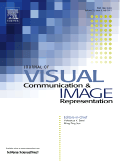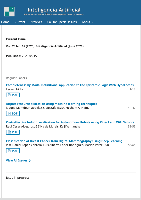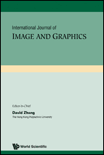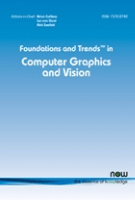
INTERNATIONAL JOURNAL OF COMPUTER VISION
Scope & Guideline
Exploring the Intersection of Vision and Technology.
Introduction
Aims and Scopes
- Computer Vision Algorithms and Models:
The journal publishes research on novel algorithms and models for tasks such as object detection, image segmentation, and scene understanding, emphasizing the effectiveness and efficiency of these approaches. - Machine Learning and Deep Learning Applications:
A significant focus is on the application of machine learning and deep learning techniques in computer vision, exploring how these methods can enhance visual perception and analysis. - Multimodal and Cross-Modal Learning:
Research on integrating information from multiple modalities (e.g., vision and language) is a core area, highlighting the importance of cross-modal understanding in computer vision. - Robustness and Adversarial Learning:
The journal addresses challenges related to the robustness of computer vision systems, including adversarial attacks and the development of resilient models. - Real-World Applications and Datasets:
IJCV emphasizes the importance of real-world applications, often featuring studies that involve novel datasets and benchmarks that reflect practical challenges in computer vision. - 3D Vision and Spatial Understanding:
Research on 3D vision, including techniques for 3D reconstruction, depth estimation, and spatial reasoning, is a prominent area of interest within the journal. - Human-Centric Computer Vision:
The journal includes studies focused on human-centered applications, such as action recognition, human pose estimation, and social interaction analysis.
Trending and Emerging
- Generative Models and Synthesis:
There is a growing trend towards the use of generative models, such as GANs, for tasks like image synthesis, video generation, and data augmentation, indicating a shift towards creative applications of computer vision. - Domain Adaptation and Generalization:
Research focusing on domain adaptation techniques is increasingly prominent, addressing the need for models to perform well across different environments and conditions. - Explainable AI in Vision Systems:
The importance of explainability in AI, particularly within vision systems, is gaining traction, with studies exploring how to make computer vision models more interpretable and transparent. - Real-Time and Efficient Processing:
There is an emerging emphasis on developing real-time algorithms and processing techniques that enable efficient deployment of computer vision systems in real-world applications. - Integration of Vision and Language:
The intersection of vision and language is becoming a hot topic, with research exploring how to combine visual understanding with natural language processing for tasks such as image captioning and visual question answering. - Robustness Against Adversarial Attacks:
Research on enhancing the robustness of computer vision models against adversarial attacks is increasingly relevant, reflecting a broader concern over the security of AI systems.
Declining or Waning
- Traditional Image Processing Techniques:
Research centered around classical image processing methods appears to be decreasing in frequency as the field increasingly shifts towards deep learning-based approaches. - Low-Level Vision Tasks:
There seems to be a waning interest in low-level vision tasks, such as basic image enhancement and denoising, as more complex applications and higher-level tasks gain attention. - Single-Modal Approaches:
Studies focusing solely on unimodal approaches, particularly those that do not integrate other sensory information (like audio or text), are becoming less common in favor of multimodal frameworks. - Static Scene Analysis:
Research dedicated to static scene analysis is declining, as dynamic and temporal analysis, including video and motion understanding, becomes more relevant.
Similar Journals

JOURNAL OF VISUAL COMMUNICATION AND IMAGE REPRESENTATION
Advancing Knowledge in Visual CommunicationJOURNAL OF VISUAL COMMUNICATION AND IMAGE REPRESENTATION, published by Academic Press Inc Elsevier Science, is an influential platform dedicated to the realms of visual communication, media technology, and advanced image representation. With a strong focus on interdisciplinary approaches, this journal aims to foster the exchange of innovative ideas among researchers and professionals in the fields of computer vision, image processing, and signal processing. Recognized for its significance, it boasts an impressive impact factor within its category quartiles; notably, it ranks Q2 in Computer Vision and Pattern Recognition and Electrical and Electronic Engineering, while achieving Q1 in Media Technology. Based in the United States, the journal not only provides valuable insights into the latest developments from 1990 to 2024 but also encourages cutting-edge research that enhances multimedia systems and user interactions. As a vital resource for students, researchers, and industry professionals alike, the journal ensures a robust understanding of visual information processing, critical for navigating today's digital landscape.

Inteligencia Artificial-Iberoamerical Journal of Artificial Intelligence
Catalyzing Progress in Ibero-American AI Studies.Inteligencia Artificial-Iberoamerican Journal of Artificial Intelligence, published by the ASOC ESPANOLA INTELIGENCIA ARTIFICIAL, serves as a pivotal platform for disseminating cutting-edge research in the burgeoning fields of artificial intelligence and software development. Established in 1997 as an Open Access journal, it ensures broad accessibility to its scholarly content, thus fostering collaboration and knowledge exchange amongst researchers, professionals, and students across the globe. Based in Valencia, Spain, the journal currently operates within a significant timeline spanning from 2004 to 2010 and 2012 to 2024, enabling continual contributions to the academic discourse. Although it holds a Q4 quartile ranking in both the Artificial Intelligence and Software categories and a notable yet competitive Scopus ranking among its peers, the journal remains committed to advancing the understanding and application of sophisticated AI methodologies. As it continues to embrace innovative research, this journal stands as a crucial reference point for those keenly navigating the complexities of artificial intelligence in a rapidly evolving digital landscape.

Computational Visual Media
Advancing innovation in visual computation.Computational Visual Media, published by TSINGHUA UNIVERSITY PRESS, is a premier open access journal dedicated to advancing the fields of Artificial Intelligence, Computer Graphics and Computer-Aided Design, and Computer Vision and Pattern Recognition. Since its inception in 2015, it has established a robust position within the academic community, consistently achieving Q1 rankings across its categories as of 2023. With exceptional Scopus rankings, including a remarkable percentile standing in the top 10% globally, the journal serves as a vital resource for researchers, professionals, and students eager to explore cutting-edge methodologies and technologies in computational visual media. The journal’s open access format enhances accessibility, fostering global collaboration and dissemination of knowledge, making it an indispensable platform for those at the forefront of innovation in these dynamic fields. The journal is headquartered in Beijing, China, and aims to publish high-quality research that not only contributes to theoretical advancements but also addresses practical challenges within computational visual technologies.

International Journal of Image and Graphics
Exploring the Intersection of Art and TechnologyInternational Journal of Image and Graphics, published by World Scientific Publishing Co. Pte Ltd, serves as an essential platform for scholars and practitioners in the realms of Computer Graphics, Computer-Aided Design, and Computer Vision and Pattern Recognition. Established in 2001 and based in Singapore, this journal has become increasingly influential, with a reputation reflected in its Q3 and Q4 rankings across key categories in Scopus, highlighting its growing impact in the academic community. Open access options remain limited; however, the journal's commitment to disseminating high-quality research allows for a rich exchange of ideas among professionals and students alike. As the 2023 metrics indicate, contributions to the journal not only enhance individual academic portfolios but also promote advancements in image processing, fostering innovation and growth within the discipline until at least 2024. It is thus a vital resource for anyone looking to deepen their knowledge and understanding of contemporary trends and technologies in image processing and related fields.

CAAI Transactions on Intelligence Technology
Catalyzing Collaboration in Intelligent Technology ResearchCAAI Transactions on Intelligence Technology is a premier peer-reviewed journal published by WILEY, dedicated to advancing the fields of Artificial Intelligence, Computer Networks and Communications, Computer Vision and Pattern Recognition, Human-Computer Interaction, and Information Systems. Since its inception in 2017, this Open Access journal has rapidly ascended the ranks, achieving Q1 quartile status across multiple categories as of 2023, and is recognized for its rigorous standards and innovative research dissemination, evidenced by impressive Scopus rankings, including Rank #12 in Computer Vision and Pattern Recognition. Through its commitment to providing a platform for high-quality research, the journal invites contributions from scholars globally, fostering a collaborative environment that stimulates intellectual exchange and encourages advancements in intelligent technology. Addressed to researchers, professionals, and students alike, CAAI Transactions on Intelligence Technology serves as a vital resource for those aiming to stay at the forefront of technological innovation.

International Journal of Advanced Computer Science and Applications
Fostering Collaboration for Tomorrow’s Tech Solutions.International Journal of Advanced Computer Science and Applications, published by SCIENCE & INFORMATION SAI ORGANIZATION LTD, stands as a significant platform in the ever-evolving field of computer science. With its ISSN 2158-107X and E-ISSN 2156-5570, the journal aims to disseminate high-quality research and innovations from diverse areas within computer science, embracing cutting-edge technologies and methodologies. As of 2023, it holds a commendable Q3 ranking in the field, placing it among a competitive cohort of journals while showcasing its commitment to scholarly excellence. The journal operates under an open access model, ensuring that its content is widely accessible to researchers, professionals, and students alike, thereby fostering a collaborative environment for knowledge-sharing and advancing the discipline. With a history of converged contributions from 2017 to 2024, the International Journal of Advanced Computer Science and Applications serves as a vital resource for those seeking to stay at the forefront of computer science research and applications.

JOURNAL OF MATHEMATICAL IMAGING AND VISION
Empowering the Future of Imaging with Mathematical RigorJOURNAL OF MATHEMATICAL IMAGING AND VISION, published by Springer, stands as a significant platform for advancing the fields of applied mathematics, computer vision, and pattern recognition, among others. With an ISSN of 0924-9907 and an E-ISSN of 1573-7683, this esteemed journal is based in the Netherlands and has been contributing to the scholarly discourse since its inception in 1992, with a converged focus through 2024. It has achieved reputable standings within several quartiles, including Q2 rankings across applied mathematics, geometry and topology, and condensed matter physics, reflecting its impact and relevance. Notably, the journal ranks within the top 5% in Geometry and Topology and maintains robust standings in Statistics and Probability. The JOURNAL OF MATHEMATICAL IMAGING AND VISION is dedicated to publishing high-quality research that bridges theoretical perspectives with practical applications, making it an essential resource for researchers, professionals, and students who are exploring the cutting-edge of mathematical imaging and its interdisciplinary applications.

Foundations and Trends in Computer Graphics and Vision
Pioneering Insights in Computer Graphics and VisionFoundations and Trends in Computer Graphics and Vision, published by NOW PUBLISHERS INC, is a premier journal dedicated to advancing the fields of computer graphics and vision. With an impressive impact factor and ranked Q1 in the Computer Vision and Pattern Recognition category, this journal has established itself as a vital resource for cutting-edge research and trends. Spanning from 2005 to 2024, it covers a wide array of topics within its scope, featuring comprehensive reviews and insights that are essential for professionals, researchers, and students alike. The journal’s high Scopus rank, placing it in the top 4 of 106 in its discipline, underscores its relevance and authority in the field. While currently not offering open access, the importance of its curated content makes it a valuable addition to any academic library and a must-read for those looking to stay at the forefront of computer graphics and vision advancements.

IMAGE AND VISION COMPUTING
Illuminating the path of progress in image analysis and recognition.Image and Vision Computing, published by Elsevier, serves as a leading international journal focused on the dynamic fields of computer vision, pattern recognition, and signal processing. With its esteemed Q1 category rankings in these areas and an impressive standing in Scopus metrics, where it ranks 19th in Computer Vision and 23rd in Signal Processing, this journal has firmly positioned itself at the forefront of academic research and innovation. Established in 1983, it continues to publish cutting-edge research that drives advancements in technology and applications across various domains. The journal is committed to disseminating high-quality, peer-reviewed articles that address significant challenges and propose novel solutions, making it an essential resource for researchers, practitioners, and students alike. While not an open access journal, Image and Vision Computing offers a wealth of valuable insights into the ever-evolving landscape of visual computing technologies.

SIGNAL PROCESSING-IMAGE COMMUNICATION
Transforming Ideas into Visual SolutionsSIGNAL PROCESSING-IMAGE COMMUNICATION, published by Elsevier, is a leading journal in the fields of Computer Vision, Signal Processing, and Electrical Engineering. With an impressive range of Quartile rankings in 2023, including Q1 in Electrical and Electronic Engineering and Q2 in Signal Processing, this journal is vital for researchers and professionals seeking the latest advancements and comprehensive studies in image communication technologies. Issued in the Netherlands, SIGNAL PROCESSING-IMAGE COMMUNICATION has been an essential resource since its inception in 1989, fostering innovation and collaboration among academia and industry. The journal provides a platform for high-quality peer-reviewed research, addressing significant challenges and solutions in the convergence of image processing and communication. Although currently not an Open Access journal, it offers subscription options that ensure a broad dissemination of groundbreaking knowledge. With a robust reputation reflected in its Scopus ranks, this journal serves as an indispensable reference for students and experts aiming to stay at the forefront of developments in this dynamic field.